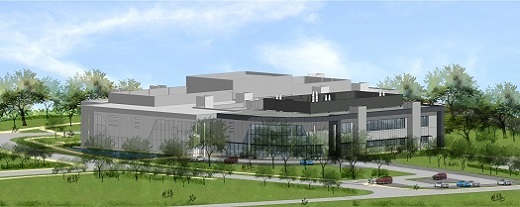With funding now confirmed for the development of a new innovation centre in the UK, the National Centre for Healthcare Photonics, Dr Tom Harvey, programme development manager for healthcare photonics at CPI, discusses the centre’s activities and how it will support the commercialisation of novel medical technologies, which will ultimately improve patient outcomes and care
A recently published study showed that in 2017, the UK photonics industry contributed more than £12.9 billion to the UK economy. The study, which is based on data from UK government agency Companies House, also indicated that the UK photonics industry is growing at twice the national average with three times the average UK productivity per worker1. This growth reflects the increasingly significant role that light plays in next-generation products and manufacturing. Europe has also recognised the importance of photonics by naming it as a key enabling technology, and supporting its development through the Horizon 2020 programme.

Photonics technologies are used across a wide range of applications, including manufacturing, healthcare, environmental monitoring, aerospace, telecommunications, and many others. Currently, one application of significant interest is the use of photonics in healthcare, which involves the use of light to diagnose and treat a wide range of acute and chronic conditions. It is a rapidly growing area globally, as photonics-based methods will help to meet the increasing demand for non-invasive, cost-effective, or rapid treatments and/or personalised care. Applications of these treatments include monitoring of physiological parameters, wounds, skin, cancer care, neurology and ophthalmology. The development of these treatments will improve patients’ quality of life and reduce our dependence on the UK’s National Health Service (NHS).
The UK has a world-class research capability in healthcare photonics; however, for adoption of photonic technologies in healthcare to increase, some key challenges must be overcome. One such challenge is to reduce the barriers that are preventing promising research and early-stage inventions from moving beyond the laboratory and into innovative healthcare solutions for patients. Barriers to adoption include reducing the risk and cost associated with the development of photonic devices. In order to address these barriers, the Centre for Process Innovation (CPI) is opening a new National Centre for Healthcare Photonics based at NETPark, County Durham in 2018. This new and internationally significant innovation centre will be financially supported with £8.3m by the Local Growth Fund, through the North East Local Enterprise Partnership.
The formation of this new centre will provide the infrastructure and support for more early-stage and small and medium sized companies to drive forward their innovations and increase their chances of commercialisation. The centre will also encourage large companies to undertake more disruptive innovation, at reduced risk with increased capital efficiencies. At the National Centre for Healthcare Photonics, CPI will collaborate with the academic, medical and clinical communities, supply and value chain partners, as well as key players within the healthcare innovation system.
The centre will focus initially on novel technologies for imaging, diagnostics and therapy. Photonic technologies at the centre will include x-rays at the high frequency end of the spectrum, through UV and visible light, the near and far infra-red up to the terahertz part of the spectrum.
What technologies will be housed at the new centre?
The centre will provide an open access, collaborative and flexible workspace for clients who wish to use the equipment and laboratories. Office space will be available to rent for clients who require being based on-site in order to carry out their work. A number of shared meeting rooms are also available along with shared exhibition/display area and break-out meeting space. Office space is also available for visiting academic or industrial researchers.
The centre intends to put in place sufficient quality management systems for it to gain the key ISO1345 standard required for the manufacture of medical devices. This will ensure that the facility is able to be part of the supply chain for partner companies who will be the legal manufacturer of medical devices including in vitro diagnostic devices.
The building has been designed to take into account the interdisciplinary nature of innovation required when developing new medical technologies. The key facilities include a manufacturing area with controlled access, temperature and humidity control, and flexible optics laboratories with re-configurable light-tight cubicles made for development and testing of optical systems. There are also several laser safe rooms; a suite of life science laboratories for the preparation and analysis of samples including human tissue and blood for research purposes; an electronics development laboratory and workshop with facilities for rapid prototyping. An x-ray test and development lab is available with two rooms with lead shielding and controlled access, as well as a modelling and design laboratory with shared access to 3D CAD design software, optics design and image analysis software. Equipment will be also available within the facility to allow customers to develop, validate and manufacture their new products to a pre-commercial level.
The new facility aims to improve key components of medical imaging systems such as the light source, detector, passive optical components (including fibre-optics), readout electronics, image processing software, and others
Alongside the infrastructure, equipment and accommodation that will be available in the centre, CPI will provide clients with services such as health economic modelling, clinical trial planning, understanding of the regulatory approval process, advice on CE marking, intellectual property protection, supply chain analysis and access to finance. These services will be delivered in partnership with existing providers.
What innovations will the new centre enable?
State-of-the-art biomedical imaging relies on non-invasive, compact, maintenance-free, cost-effective technologies that can be performed quickly and reliably to reduce patient waiting times. Technical advances in the design and manufacture of key components such as swept source lasers mean that there is the potential for medical imaging systems to run multiple times faster than they do currently and with noticeable improvements to the contrast, resolution, imaging depth and repeatability. As the laser sources make the transition from using discrete mechanical components to monolithically integrated semiconductor systems, the costs can be significantly reduced. Optical coherence tomography (OCT) is already benefiting from these improvements.
The new facility aims to improve key components of medical imaging systems such as the light source, detector, passive optical components (including fibre-optics), readout electronics, image processing software, and others. In addition, multi-modal imaging methods including photonics, such as opto-acoustic imaging, offer improvements in resolution and depth that are not possible with individual techniques alone.
Photonic-enabled diagnostic methods are non-contact and can be done in vivo or in vitro, with or without additional probes, contrast agents or other types of marker. The centre’s aim is to help improve the range and utility of photonic diagnostic methods available, with a focus on reducing the cost of manufacture of those devices. This will help to address established market trends such as the move away from hospital-based and delivered services towards more local or personal testing and diagnosis. Photonic-enabled therapies include low light phototherapy and photo-dynamic therapies. Medical laser based methods are also covered.
Collaboration with innovation centres such as CPI’s National Centre for Healthcare Photonics will be essential to enable companies to get their novel photonics-enabled products to market more quickly at reduced risk. These innovations, such as new products for imaging, diagnostics and therapy, will have the potential to address healthcare challenges, deliver cost-effectiveness, as well as provide great improvements to patient care. In the long-term, the new centre will help to enable the UK to be recognised as a global leader in the field of healthcare photonics, as well as generating a large number of jobs in the North East.
If you think that your organisation could benefit from collaborating with the new National Centre for Healthcare Photonics, if you have a specific product or project idea that you would like to discuss with us, or you would just like to find out more about the Centre, please get in touch with Dr Tom Harvey, programme development manager for healthcare photonics at CPI (tom.harvey@uk-cpi.com).
References


